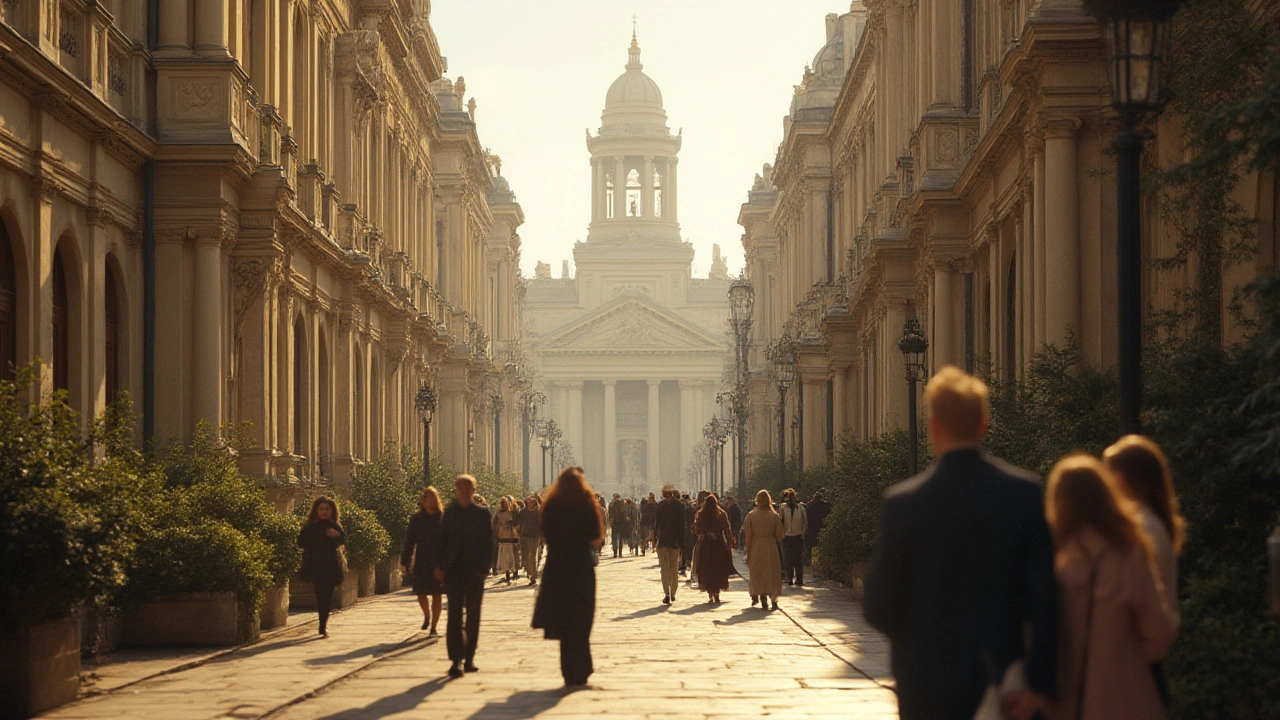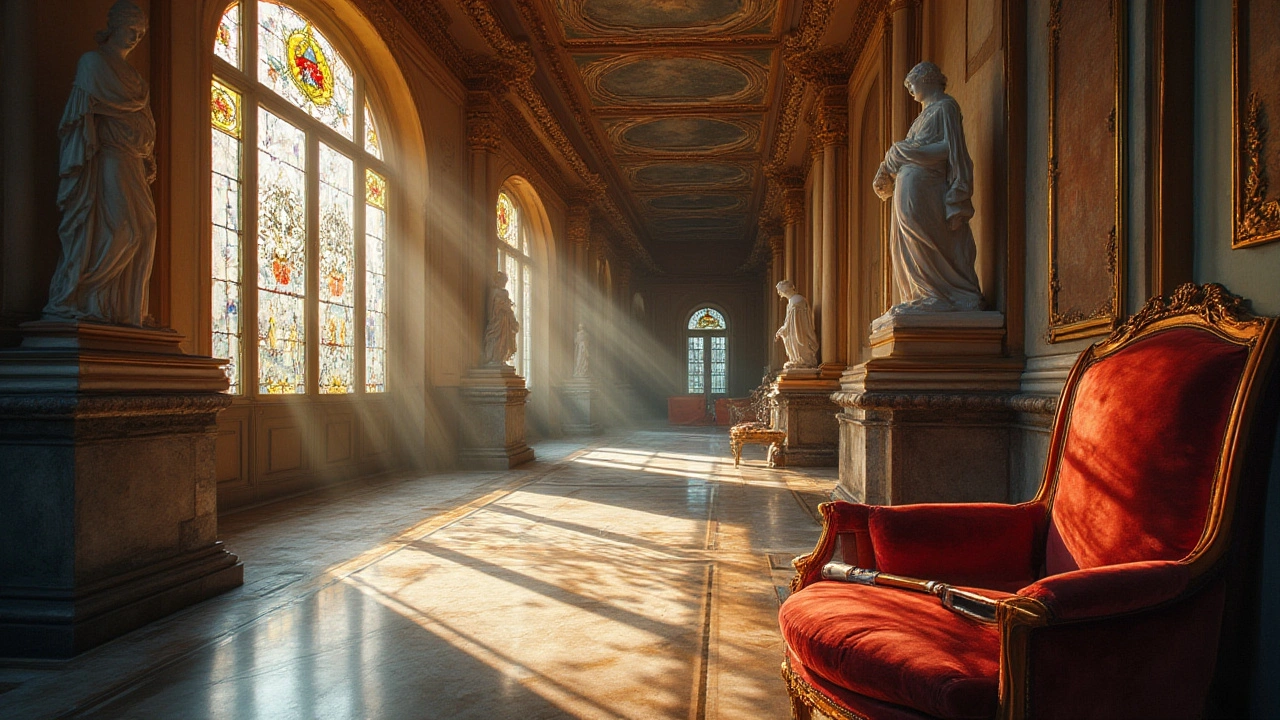Renaissance Revival Architecture: Key Features, History & Modern Appeal
 Jul, 12 2025
Jul, 12 2025
You walk into a city and suddenly spot a building crowned with balustrades, ornate brackets under the eaves, and windows that arch gracefully overhead. The facade practically challenges you to guess its origins. This isn’t just a throwback or a careless amalgam of old trends. It’s the Renaissance Revival, a style that doesn’t whisper for attention—it demands it, borrowing from the artistry of 15th and 16th-century Italy and making its mark in every major city from Paris to New York.
The Historical Return of Classic Grandeur
The fascination with Renaissance Revival architecture exploded in the 19th century right around the time the world was craving order after the chaos of wars and revolutions. Designers didn’t just want to copy what had worked in the past; they wanted to add that sense of permanence, drama, and sheer ambition that spoke of a city’s or a person’s power. Think of The Breakers in Rhode Island, or Berlin’s Neue Museum. Some of these places feel like they belong in a movie—maybe that’s why directors keep using them.
While true Renaissance designs originated in Italy under architects like Filippo Brunelleschi, the revivalists weren’t shy about tweaking the recipes. Instead of just copying rectangular forms and harmonious proportions, they’d pile on classical details: columns modeled after ancient temples, window surrounds carved in limestone or marble, and sometimes a little too much gilding just to remind you who paid for it. Europe practically tripped over itself embracing these motifs—France called it Second Empire, Germany had its Neo-Renaissance movement, and even Russia tried to outdo the Italians for opulence.
By the time the style reached the United States, wealthy industrialists and city officials turned to architects like Richard Morris Hunt to make their dreams of grandeur real. Suddenly, a public library, a statehouse, or even a fire station could resemble a Florentine palace. At the heart of this craze sat one goal: show off knowledge, progress, and sophistication. Even Seattle, where I live, got a piece of it—the city’s historic libraries and museums hang onto decorative schemes drawn from this rich legacy.
The Renaissance Revival wasn’t just about holding onto the old glory, though. It was a rebellion against the blandness creeping in due to industrialization. People wanted the assurance of beauty and craftsmanship at a time when machines were taking over. Even today, neighborhood tours and architecture nerd meet-ups light up when someone points out a building topped by a classic cornice or details with rosettes and swag garlands. These days, you’ll find original plans and blueprints stored in university archives, and tours explaining how the Renaissance Revival changed city skylines step by step.
Here’s a quick fact: in Paris, the Louvre’s major expansions in the mid-19th century perfectly illustrate how Renaissance Revival appeared different in every country. French designers made everything bigger and flashier, with deep-cut pediments and colonnaded walkways—a style that still makes tourists stop for photos today. So, it’s a lot more than just nostalgia; it’s the story of a society desperate to be seen, adored, and remembered.
| Region | Signature Renaissance Revival Example | Year Completed |
|---|---|---|
| USA | The Breakers (Rhode Island) | 1895 |
| France | Louvre Extensions | 1857-1870 |
| Germany | Neue Museum (Berlin) | 1855 |
| Russia | State Historical Museum (Moscow) | 1872 |
Distinctive Elements: What Sets Revival Apart?
So how do you actually spot Renaissance Revival architecture in the wild? For one, it loves a symmetrical layout—no lopsided towers or spindly lines here. Picture a bold central door flanked by evenly spaced windows, sometimes with a little terrace or balustrade above to show off the effect. Doors tend to be grand, framed by strong pilasters (flat columns), and sometimes topped by pediments curling like eyebrows.
Look up and you’ll probably find a roofline that seems heavier than it needs to be. Those broad, flat, or gently sloped roofs seem to balance atop rows of brackets (called modillions) and cornices stacked with ornamental moldings. Flat as a pancake isn’t the rule—they’ll throw in a cupola or domed crest when they want to show off. Window treatments are over-the-top: arched, paired up, or even grouped in threes with rounded tops, and frames sometimes so detailed they could double as picture frames in a museum. In fact, sometimes the window frames really were artworks designed by skilled artisans, not mass-produced at all. (And at the time, it would take weeks to hand-carve the floral swags and medallion heads.)
Inside, you’ll often find a central staircase that’s more about being seen than simply changing floors. Marble floors, elaborate plaster ceilings, massive fireplaces with carved mantels—a party in every corner. Libraries, ballrooms, and studies got extra attention, with coffered ceilings and richly painted borders. Functional spaces like kitchens? Tucked out of sight, so the formal rooms could impress guests.
Let’s not forget the decorative elements—this style loves a motif. Scrolls, acanthus leaves, palmettes, and mythological faces appear on everything from doorknobs to domes. Renaissance Revival meant you could never go too far with ornament. If Parisian designers used too much gold leaf or if a Russian tycoon wanted jewel-colored tiles, so what? The style feeds on excess, sometimes quite literally—when a building was finished, parties would spill across its massive halls, just to prove the owner could afford such luxury.
One quirky touch: Some buildings mixed genuine antique elements with modern engineering. Steam-heated marble floors, elevators disguised in rich woodwork, and top-of-the-line gas lighting were among the hidden perks. The revivalists wanted comfort as well as beauty—they just didn’t want you to see the pipes or bulbs.
If you’re restoring or buying a Renaissance Revival home, a smart tip is to watch for original woodwork and plaster, as these cost a small fortune to replace. Get help from specialized craftsmen if these details need repair; this isn’t a job for a general contractor. And skip covering up details with modern drywall or paint unless it’s absolutely needed—the patina and light wear are part of the building’s charm. Antique fixtures or reproduction tiles from specialist shops can help keep any renovations in the spirit of the period.

How Renaissance Revival Shapes Modern Architecture
Here’s where it gets really interesting. Renaissance Revival didn’t just vanish—it turned into a toolkit for architects looking to add drama to otherwise boring spaces. Even public buildings and schools wanted to look important, centuries after the golden age of Italy had passed. The bones of Renaissance design are everywhere; modern city halls, university libraries, and even some shopping centers keep the symmetry, robust proportions, and formal window groupings alive, just toned down a bit.
Some architects treat these elements like a secret code—the use of a grand staircase or pilaster hints that a public building should command respect or awe. In brand-new luxury residences popping up in places like Los Angeles or London, fancy rooftop terraces lined with balustrades nod straight to the Revival style. I was honestly surprised to see how many architects in Seattle add subtle details inspired by historic palazzos: it might be a cornice echoing the Medici palaces, or just a symmetrical garden plan tucked behind a glassy modern facade.
Renovations are a massive part of this story, too. People love the bones of old buildings, so when apartments, hotels, or even tech offices move into a Renaissance Revival property, architects keep what works—the sweeping staircases, detailed plasters, and grand entrances—while sneaking in modern kitchens, bathrooms, and efficient lighting systems. Seattle’s own Frye Art Museum is a case study in this: its original Renaissance Revival details coexist with 21st-century enhancements, almost as if time simply folded the new into the old rather than erasing the past.
Eco-friendly designers are also catching onto the magic. Old-manor updates now include discreet solar panels on slate roofs or high-efficiency windows hand-fitted to look like the originals. There’s even a growing trend to use 3D printing for restoration parts, ensuring the replacement pieces fit right into place while still matching the original sketches from the 1880s. The opportunity to merge new tech with tradition leaves me giddy—Anthony jokes that someday every house we ever own will have a secret passage or a fake coffered ceiling. Maybe he’s right.
If you’re looking to add some Revival magic to your space, start small. Reproduction medallion light fixtures or ornate door hardware set the vibe. If you’re ready for a bigger leap, symmetrical landscaping—think orderly potted plants, gravel paths, stone benches—works wonders outdoors. And while not everyone can swing an authentic fresco on their ceiling, wallpaper with classic patterns comes close enough for most of us.
| Modern Renaissance Revival Use | Example |
|---|---|
| Public Library | New York Public Library (Restoration 2020) |
| Luxury Hotels | From Grand Hotel Tremezzo to Downtown Seattle’s Hotel Sorrento |
| Residences | Hollywood Hills Mansions—2024 Architectural Digest |
| Tech Offices | Refurbished Seattle Pioneer Square Buildings |
"Renaissance Revival architecture, with its blend of formality and flair, teaches us that beauty and function are not just old friends—they're lifelong partners." – Ada Louise Huxtable, legendary architecture critic
Practical Tips for Experiencing and Preserving Renaissance Revival
If you’re trying to experience Renaissance Revival for yourself, the good news is, you don’t need a passport. There’s a decent chance you’re within driving distance of at least one library, mansion, or museum dressed in this style. Some of the best examples are open to the public, like the original Frick Collection in New York, or the National Gallery of Art’s West Building in Washington, D.C. Even self-guided street walks in cities like Boston, Chicago, or San Francisco can turn into scavenger hunts for keystone arches and paired columns.
Preserving Renaissance Revival architecture is another adventure. Many historic preservation societies—there are dozens in most states—run workshops on how to handle materials like terra cotta, limestone, or old hardwoods. Even small repairs, like stripping paint from carved plaster, can be tricky. Local universities sometimes offer short courses in restoration, so if you’ve ever wanted a hobby that combines art with history, this might be it.
Tour guides and architecture critics love tossing out interesting facts: did you know original Revival buildings could take up to seven years to finish because of the amount of handwork involved? Tiles and bricks were often imported from Europe, causing costs to balloon. Owners kept tabs on artists, sometimes even having their initials hidden in decorative details. Seattle’s own Arctic Club features original terra cotta walrus heads—because why not?
If you’re lucky enough to own a Revival-era home, make friends with other owners. There’s always someone who knows a specialist contractor, a window restorer, or just has experience sourcing the right hardware at salvage yards. Take lots of pictures before you start any restoration project—sometimes layers buried under bland 1970s wallpaper hide hand-painted patterned trim or lost stonework. Preserving these touches might take more time, but it always pays off in character and pride.
For design fans just starting to explore, grab a book dedicated to this style—titles by respected critics give a great introduction. And if you’re traveling, search out the big name sites. You don’t have to visit Florence or Vienna—your local city might have “hidden” gems that are just as breathtaking once you know what to look for. Try making a checklist: keystone arches, a central front door, rows of columns, and that unmistakable over-the-top roofline.
I’m always convinced that part of why Renaissance Revival won’t ever fully fade away is that it feels like it belongs to both the public and the private. From once-secret societies and grand hotels to family homes where daily routines unfold under painted ceilings, this style moves us. Whether you’re walking past a decorated cornice or restoring a bit of history, you’re part of a story that started 600 years ago and just keeps getting better.